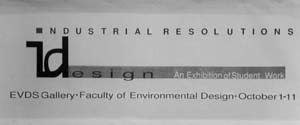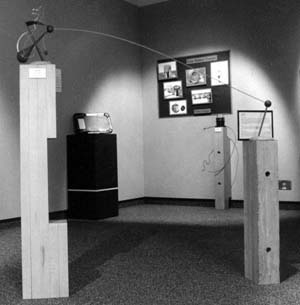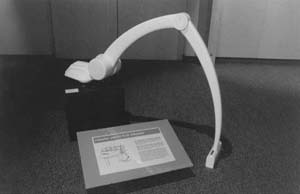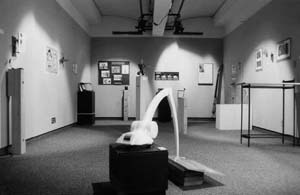
Research & Professional Activity
THE GALLERY EXHIBITION
Industrial Resolutions
by Sean Stanwick

On my first visit to the Student Work In Industrial Design Exhibit, I scanned the room, whisked through, stopping only for a very short moment at the one or two projects that happened to catch my attention. There seemed nothing unusual about this, for I have never been one for long ponderous moments in any gallery. After all, there was still an entire weekend of email to read. Yet, as I passed the gallery each morning after that, I couldn't help but feel as though I had missed something the first time around. Besides, Poul Lasson's robotic hull cleaner modeled after a crab's leg kept catching my eye. So, I decided to give it another go.
The tangible products, real objects which I could see, touch and gain an immediate understanding of, are what impressed me most about this show. |
As an architecture student, I have seen plenty of detailed models and groovy graphics in my time. Or, at least I thought so. The quality and variety of work displayed was most impressive. Designs stemming from purely functional needs such as Erez Pedro's redesign for a safer utility knife utilizing a rotary blade were of particular interest to me as someone who has accidentally `trimmed' off the end of their thumb on more than one occasion. Motivated by technical innovations, Ross Mitchell's cellular phone with an infrared LCD screen connection took a traditional design approach whereas the Crystal Radio for Children designed by Ainsley Price combined bright colors and whimsical forms in a fun and playful composition. For the home, Bruce Hanington's food preparation center was an inventive evolution to the traditional kitchen cutting board, incorporating both a cutting surface and detachable service containers. Mieka West's cocktail table, and Thea Bornstein's floor lamp, in their simplicity, skillfully integrated hard and soft materials such as steel and wood to create warm, intimate designs. Although the projects were quite diverse, what appeared common among them was a consistent and serious effort to produce prototypes which were as realistic as possible. Even the smallest details were represented - details which often get overlooked, and in many cases it is the finer points that can raise the quality of a project.
 |
| Ainsley Price's "Crystal Radio" |
As much as I hate to admit it though, I was captivated more by how the prototype was actually made, and less interested in what the project was designed to do. What intrigued me was the ingenuity in the use of materials such as wood, plexiglass, and liquid form molds. The constant effort to include even the most minute details further excited my curiosity in the construction process. I found myself asking other students "what was that made of?" and "just how did you do that?". Nonetheless, the models were of a quality and skill I had not seen in any of my previous design studios. The tangible products, real objects that I could see and touch and gain an immediate understanding of, are what impressed me most about this show.
 |
| Poul Lasson's robotic hull cleaner |
The level of serious design considerations put into these design projects was immediately evident. Most were actual working prototypes designed around specific needs and guidelines. There is no doubt that the quality of the work was of a high caliber and that the students take their role as designers seriously. As a design student myself, I can honestly say that I was impressed by this exhibition and I am certainly looking forward to the next one.
 |
[ Top of Page | Table of Contents | Intervention | Previous Article | Next Article ]